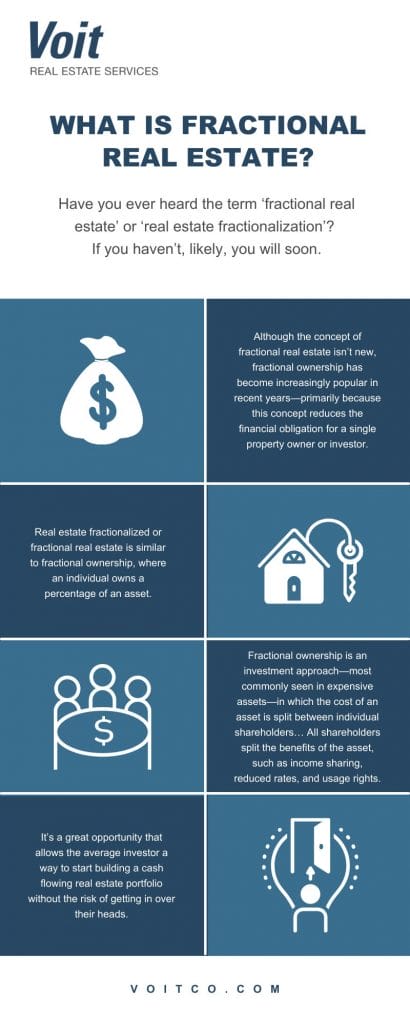
Reviewing “Startups Are Looking To Fractionalize Real Estate Assets, But Should They?”
Have you heard the term ‘fractional real estate’ or ‘real estate fractionalization’? If you haven’t, you likely will soon.
Read on to learn a little bit about what fractional real estate is. Then, we’re handing over the reins to Forbes with their article “Startups Are Looking To Fractionalize Real Estate Assets, But Should They?”
What is Real Estate Fractionalization?
Although the concept of fractional real estate isn’t new, fractional ownership has become increasingly popular in recent years—primarily because this concept reduces the financial obligation for a single property owner or investor.
Fractionalized real estate or fractional real estate is similar to fractional ownership, where an individual owns a percentage of an asset.
Moreover, fractional ownership is an investment approach—most commonly seen in expensive assets—in which “the cost of an asset is split between individual shareholders… All the shareholders split the benefits of the asset, such as income sharing, reduced rates, and usage rights.”
Why Fractional Real Estate?
According to Benzinga, fractional real estate investments are heating up.
Why? It’s a great opportunity that gives “the average investor a way to start building a cash flowing real estate portfolio without the risk of getting in over their heads.” In this case “getting in over their heads” means dealing with finding tenants, property management, etc.
This concept bodes the question of the role that fractionalized real estate will take in the coming years.

Read on for the full article from Forbes.
Startups Are Looking To Fractionalize Real Estate Assets, But Should They?
Investing in commercial real estate or vacation rental properties can be a consistent source of passive income and returns, not to mention growth and the potential liquidity you don’t get with owning your home. Yet the price of entry is often prohibitive to all but those who already have wealth. This was the puzzle Drew Sterrett wanted to solve in 2017, when he worked as an analyst at asset manager Tungsten Partners, focused on real estate. He spent all day looking at the potential investment returns as he poured over the numbers and helped the firm structure deals. He wanted in.
Sterrett believed he had the background needed to be successful. What he didn’t have was the capital required for a retail investor like him to get involved in the way he wanted. “Real estate is one of the largest wealth creators in the world, but it’s really been held off for the less than 1%, the 0.1% [of people], to invest side by side with institutional investors,” Sterrett tells Forbes.
If an asset was broken up, Sterrett realized, each tranche could be priced low enough to eliminate the financial hurdle, just like stock ownership. He cofounded LEX to do that. The New York-based startup acts as a securities broker to help existing owners of commercial buildings hold a public offering of shares for accredited and nonaccredited investors to buy and trade on LEX’s marketplace. “We are removing the cost of entry and many, or all, of the limitations,” he says. “We are now bringing [real estate investing] to the many and allowing them to gain access to a market they never thought they would be able to.”
LEX isn’t alone. The company joins a growing number of startups capitalizing on the concept of fractionalizing real estate assets. Each has its own strategy. Miami-based Here offers a marketplace of stakes into existing vacation rental properties. And Toronto-based Vesta Equity allows homeowners to tokenize and sell portions of their ownership as NFTs. Yet all claim the same mission of opening up the asset class to allow more access to its potential riches, and have the fees to create a great balance sheet. Market insiders and investors however, aren’t sure this strategy is the best idea for the market or the underlying users.
Clelia Warburg Peters, a longtime proptech investor and managing partner of Era Ventures questions whether the average investor is really prepared to tackle the nuances of the real estate asset class. She also wonders what problem these companies are really solving, as retail investors already have the ability to invest in real estate through real estate investment trusts (REITs) and many don’t. “The level of education in the public even around holding REITs is pretty low,” she tells Forbes. “This is literally exposure to a direct asset or a pooled vehicle of private assets, there is both education needed and risk.”
Market analysts, meanwhile, find this a dubious strategy in current market conditions. The pandemic-driven frenzy which drove up demand and lowered mortgage prices has started to cool, points out Gay Cororaton, a senior economist at the National Association of Realtors, who expects this to continue. If home ownership becomes more affordable, some potential customers may choose to purchase a full property, rather than invest in real estate assets. What’s more, fear around investors not knowing what to do may be overblown though, she adds. Mom and pop landlords maintain a lionshare of residential assets and many didn’t come to the industry with a real estate background.
On the commercial side, L.D. Salmanson, the CEO of real estate data and analytics startup Cherre, says it all depends on the asset. Warehouses and other industrial buildings including data centers have seen continued strong performance, he tells Forbes. But assets like retail and office buildings are just too up in the air right now to be a solid investment strategy. “Office is not doing well right now, it’s an open question whether that’s temporary or long term,” Salmanson says. “I can make the argument both ways.”
Yet the founders of both LEX and Here suggest their offerings aren’t any riskier than, say, downloading Robinhood and pouring money into stocks with no guidance, or backing early-stage startups on crowdfunding sites. Plus, the users of these startups aren’t stuck with the physical asset at the end of the day.
Here looks to avoid some of the risk by performing robust due diligence on the investment options on its platform, founder Corey Ashton Walters tells Forbes. While future performance isn’t guaranteed, the startup lists only existing vacation rentals that already produce 10% to 20% yearly booking yields. “We want to keep the wheels on the bus,” he says. “If an asset is doing well, they will continue to do well. Instead of one owner, there are hundreds of owners.” All assets on LEX were already producing a stable cash flow, according to Sterrett.
There’s also definitely a demand. When LEX officially launched in November, it had 10,000 potential members on its waiting list. And commercial property landlords are showing strong interest in working with the platform, too. Here launches this week with more than 20,000 members waiting to invest. Vesta Equity, currently only available only to accredited investors, plans to open its platform to non-accredited investors within the next 12 months. Even before its February launch, Vesta Equity says it had hundreds on its waiting list and has since been approached by real estate developers interested in expanding Vesta’s offering as well.
All three real estate investing startups offer a new slate of options to the market. For LEX and Here, it’s opening a new avenue for retail investors looking to differentiate their assets. For Vesta Equity, cofounder Michael Carpentier says that the tokenized platform doesn’t just provide a new opportunity for investors, it gives homeowners a new strategy to gain liquidity without having to move. “Imagine if you had $100,000 of cash in your wallet, nice you’ve got that, but you can’t use it, you have to borrow against it,” he says about the current system.
While all these startups have users and venture backers, it’s too early to see if their mission statements outweigh the risks.